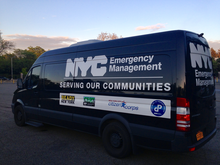
New York City Emergency Management
 | |
 Agency van with current logo. | |
| Agency overview | |
|---|---|
| Formed | 1996 |
| Jurisdiction | City of New York |
| Headquarters | 165 Cadman Plaza East Brooklyn, NY |
| Employees | 209 (2020[update])[1] |
| Annual budget | $473 million (FY 2020) |
| Agency executives |
|
| Key document | |
| Website | www1 |
New York City Emergency Management (NYCEM) (formerly the New York City Office of Emergency Management (OEM)) was originally formed in 1996 as part of the Mayor's Office under Rudolph W. Giuliani.[2] By a vote of city residents in 2001 it became an independent agency, headed by the commissioner of emergency management.[3][4] In 2006 the office was reorganized under the deputy mayor for administration by Mayor Michael Bloomberg.

Agency structure
The agency is responsible for oversight and development of the city's emergency management plans. NYCEM regularly tests plans by conducting drills and exercises, and responds to emergencies to ensure that other agencies not only follow these plans, but to foster communication amongst the responding agencies.[5] NYCEM also operates the city's Emergency Operations Center (EOC) where city, state and federal agencies join representatives from the private and nonprofit sectors to coordinate complex responses to emergencies and disasters.

The agency also developed and runs the Notify NYC emergency alert program, by which citizens can sign up to receive phone and email alerts about emergencies and events happening in their neighborhoods.

The agency is also the administrator of New York City's community emergency response teams. Each community emergency response team (CERT) is coterminous with one or more New York community boards.

New York City Emergency Management maintains the Citywide Incident Management System[6] which is based on the National Incident Management System.

The former commissioner of NYCEM is Deanne Criswell, a former FEMA official and head of OEM for the city of Aurora, Colorado. After Criswell became FEMA Administrator, John Scrivani was named commissioner.[7]

7 WTC and post-9/11 buildings
From 1999 until September 11, 2001, New York City's Emergency Operations Center was housed on the 23rd floor of the 7 World Trade Center building.[8][9] Prior to the decision to use 7 World Trade Center, MetroTech Center, in Brooklyn, was also considered for the Emergency Operations Center.[10]

Richard Sheirer was the director of the OEM at the time of the September 11 attacks, and thus became in charge of the city's rescue and recovery effort.[2][11] As the office in the World Trade Center was severely damaged, OEM was temporarily housed at Pier 92 of New York Passenger Ship Terminal on Manhattan's West Side. Pier 92 was chosen because OEM had scheduled a bio-terrorism exercise for September 12, 2001 called Operation TriPOD. (The exercise was later conducted on May 22, 2002.)[12]

Before moving into the new building, OEM was located in a warehouse beneath the Brooklyn Bridge.

New building
The new structure formerly served as the New York City headquarters for the American Red Cross of Greater New York. The $50 million project, funded by the federal government, called for the fifty-year-old building to be completely gutted and outfitted with the latest in audio-visual and communications technology.



On December 5, 2006, Mayor Michael Bloomberg joined OEM commissioner Joseph F. Bruno, former OEM directors Richard Sheirer and John Odermatt, NYCEM personnel, and a host of other dignitaries to unveil the agency's new state-of-the-art headquarters. The new facility, located at 165 Cadman Plaza East in Downtown Brooklyn.[13] It replaces the agency's former offices that were located on the 23rd floor of 7 World Trade Center, the 47-story building that collapsed in the September 11, 2001 attacks.

The new NYCEM building has three floors with 65,000 square feet (6,000 m2) of space.[14][15] It contains general offices for NYCEM staff, several conference rooms, the Joint Information Center (a press corps composed of press officers from several city agencies who disseminate information to the public), a state-of-the-art media briefing room, Watch Command, and the city's Emergency Operations Center (EOC). There is also space for senior officials to meet and the building is staffed 24-hours a day, seven days a week.

The nerve center of NYCEM is its Watch Command. It is staffed 24/7 with representatives from the city's public safety agencies. They monitor police and fire broadcasts and dispatch NYCEM Field Responders if an incident warrants. Watch Commanders also have access to New York City's 911 systems and are responsible for alerting local, state, and federal officials of emergencies. They maintain direct contact with the New York State Emergency Management Office and surrounding jurisdictions to lend support or aid if needed.

NYCEM's new headquarters is home to the Emergency Operations Center. The EOC serves as a central clearinghouse where local, state, and federal agencies can gather to assess and respond to a number of emergencies. Activated for numerous events, the new EOC contains workstations for some 130 city, state, federal, and non-profit agencies.[16] There is secure communications equipment, large video displays, and space for Geographic Information Systems. The new structure also has the distinction of being New York City's first “green” agency headquarters utilizing energy-saving and environmentally sound construction techniques. OEM qualifies for the Leadership in Energy and Environmental Design (LEED) Silver certification for its new building.

According to Commissioner Bruno at the unveiling ceremonies, “New York City is at the forefront of emergency management planning and this new facility will continue to move us forward.”[17]

Post-disaster modular housing

NYCEM has shipping container based modular temporary post-disaster housing units for evaluation next to its headquarters.[18][19] The units were designed by Garrison Architects and can be stacked up to four stories high.[20] The prototype building consists of a 480 sq ft (45 m2) single bedroom top floor and two 813 sq ft (75.5 m2) three-bedroom floors.[21][22]

Agency executives
- Jerome Hauer – Director, 1996–2000
- Richard Sheirer – Director, 2000–2002
- John T. Odermatt – Director, April 4, 2002[23] – December 2003[24]
- Joseph F. Bruno – Commissioner, March 4, 2004 – June 27, 2014[25][26][27]
- Joseph Esposito – Commissioner, June 27, 2014 – June 30, 2019 [28][29]
- Deanne Criswell – Commissioner, July 1, 2019 – 2021 [30]
- John Scrivani – Commissioner, 2021
- Andrew D’Amora – Commissioner, 2021 – January 2, 2022
- Christina Farrell – Acting Commissioner, January 3 to February 17, 2022
- Zach Iscol – Commissioner, February 17, 2022 – present[citation needed]
See also
- United States government operations and exercises on September 11, 2001
- Rescue and recovery effort after the September 11 attacks on the World Trade Center
- Notify NYC
References
Notes

- ^ "Fiscal Year 2020 New York City Government Workforce Profile Report". New York City Department of Citywide Administrative Services. Archived from the original on February 13, 2023. Retrieved February 13, 2023 – via shinyapp.io.
- ^ a b Weber, Bruce (2012-01-19). "Richard J. Sheirer, Official in Charge of Sept. 11 Rescues, Dies at 65". New York Times. Retrieved 2012-02-04.
- ^ Worth, Robert (7 November 2001). "THE 2001 ELECTIONS: BALLOT QUESTIONS; All 5 Proposals Approved For Revision of City Charter". The New York Times. Retrieved 21 October 2017.
- ^ "New York City Campaign Finance Board: The 2001 Voter Guide". www.nyccfb.info. New York City Campaign Finance Board. Retrieved 21 October 2017.
- ^ Frost, Mary (October 22, 2014). "Disaster drill at Brooklyn OEM preps for nuclear blast in Manhattan | Brooklyn Daily Eagle". www.brooklyneagle.com. Retrieved 2 October 2017.
- ^ "Citywide Incident Management System - NYCEM". www1.nyc.gov. City of New York. NYC Emergency Management. Retrieved 18 October 2017.
- ^ "Meet the Executive Staff - NYCEM". www1.nyc.gov. Retrieved 29 May 2021.
- ^ Chan, Sewell (May 15, 2007). "Giuliani, 9/11 and the Emergency Command Center, Continued". The New York Times. Retrieved 2 October 2017.
- ^ Rashbaum, William K. (2008). "Memo Details Objections to Command Center Site". The New York Times. Retrieved 2 October 2017.
- ^ Barrett, Wayne (July 31, 2007). "Rudy Giuliani's Five Big Lies About 9/11 | Village Voice". The Village Voice. Retrieved 2 October 2017.
- ^ Griscom, Amanda (October 8, 2001). "Man Behind the Mayor". NYMag.com. New York Magazine. Retrieved 27 October 2017.
- ^ "Office of Emergency Management - Press Release: May 22, 2002 - Operation TriPOD". 26 June 2003. Archived from the original on 26 June 2003. Retrieved 27 October 2017.
{{cite web}}: CS1 maint: bot: original URL status unknown (link) - ^ "Mayor Bloomberg Discusses New OEM Headquarters During Weekly Radio Address". The official website of the City of New York. 2006.
- ^ Flynn, Kevin (April 23, 2002). "Brooklyn building to house replacement crisis bunker". The New York Times. Retrieved 2 October 2017.
- ^ Hill, John (2011). Guide to Contemporary New York City Architecture. W. W. Norton & Company. ISBN 9780393733266.
- ^ Sandy, Smith (14 December 2006). "New York Unveils New Emergency Management Headquarters". EHS Today. Retrieved 2 October 2017.
- ^ "Mayor Bloomberg and OEM Commissioner Bruno Open New OEM Headquarters and Emergency Operations Center". The official website of the City of New York. 2006-12-05. Retrieved 2017-03-12.
- ^ Dailey, Jessica (Mar 6, 2013). "Post-Disaster Shipping Container Housing Coming to DoBro". Curbed NY. Retrieved 2 October 2017.
- ^ Chaban, Matt A. V. (19 October 2015). "New York City Tests Post-Disaster Housing That Stacks Up". The New York Times. Retrieved 8 October 2017.
- ^ "City tests modular post-disaster housing at Cadman Plaza". The Real Deal New York. 20 October 2015. Retrieved 2 October 2017.
- ^ Lee, Kevin (June 11, 2014). "NYC's Prefab Post-Disaster Housing Units Unveiled in Brooklyn (PHOTOS)". Inhabitat.com. Retrieved 8 October 2017.
- ^ Bindelglass, Evan (October 20, 2015). "What It's Like to Spend a Night in NYC's Post-Disaster Housing". Curbed NY. Retrieved 2 October 2017.
- ^ Cardwell, Diane (5 April 2002). "Bloomberg Fills Gaps, Naming Four to Posts In His Administration". The New York Times. Retrieved 16 October 2017.
- ^ "Mayor Michael R. Bloomberg Announces the Resignation of Office of Emergency Management Commissioner John T. Odermatt". The official website of the City of New York. November 12, 2003. Retrieved 8 October 2017.
- ^ NYC OEM. "NYC OEM Press kit" (PDF). NYC OEM. Retrieved 16 October 2017.
- ^ "OEM - About OEM - Commissioner Bruno". Archived from the original on 2012-03-20. Retrieved 2012-03-19.
- ^ "New York City OEM Commissioner Joseph Bruno Resigns". CBS News New York. CBS News. June 18, 2014. Retrieved 16 October 2017.
- ^ "Mayor de Blasio Appoints Joseph Esposito as Commissioner, Office of Emergency Management". The official website of the City of New York. June 27, 2014. Retrieved 16 October 2017.
- ^ Goodman, J. David (December 4, 2018). "City Hall Planned to Quietly Replace Its Top Emergency Official. Then Things Got Complicated". The New York Times. Retrieved 14 July 2019.
- ^ Dienst, Jonathan; Russo, Melissa (June 4, 2019). "Deanne Criswell Named New NYC Emergency Management Commissioner". NBC New York. Retrieved 14 July 2019.
Bibliography

- Rashbaum, William K.; O'Donnell, Michelle (April 3, 2004). "ROLES IN DISASTER CAUSE RIFT IN CITY". The New York Times. Retrieved March 12, 2017.
External links
- Official website
- Press Release, Office of Mayor Michael R. Bloomberg
- NYCEM Agency History
See what we do next...
OR
By submitting your email or phone number, you're giving mschf permission to send you email and/or recurring marketing texts. Data rates may apply. Text stop to cancel, help for help.
Success: You're subscribed now !
